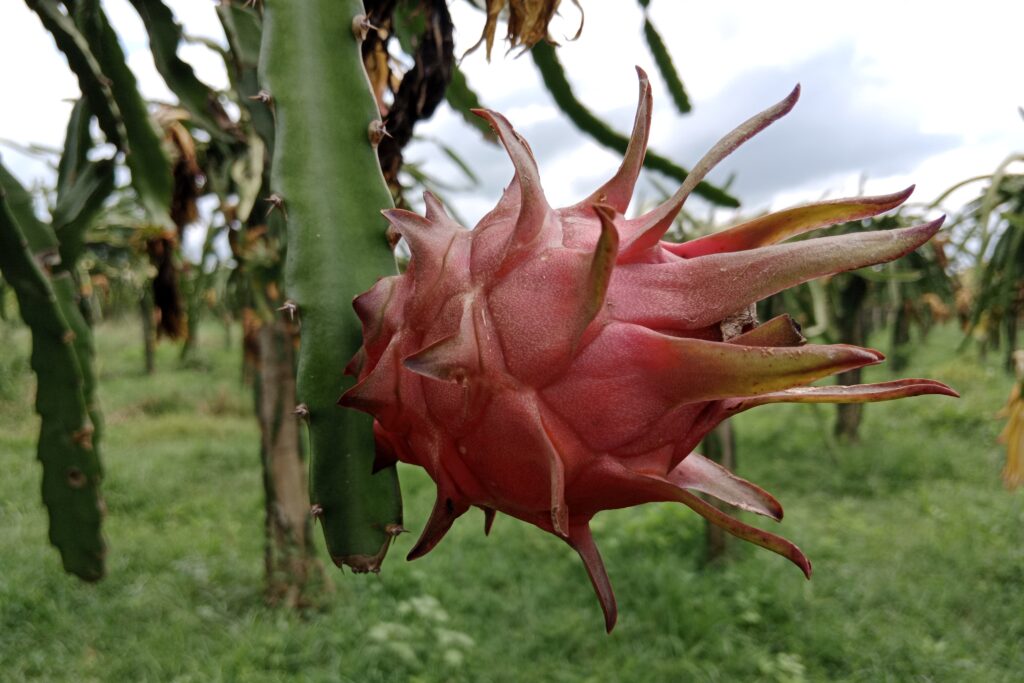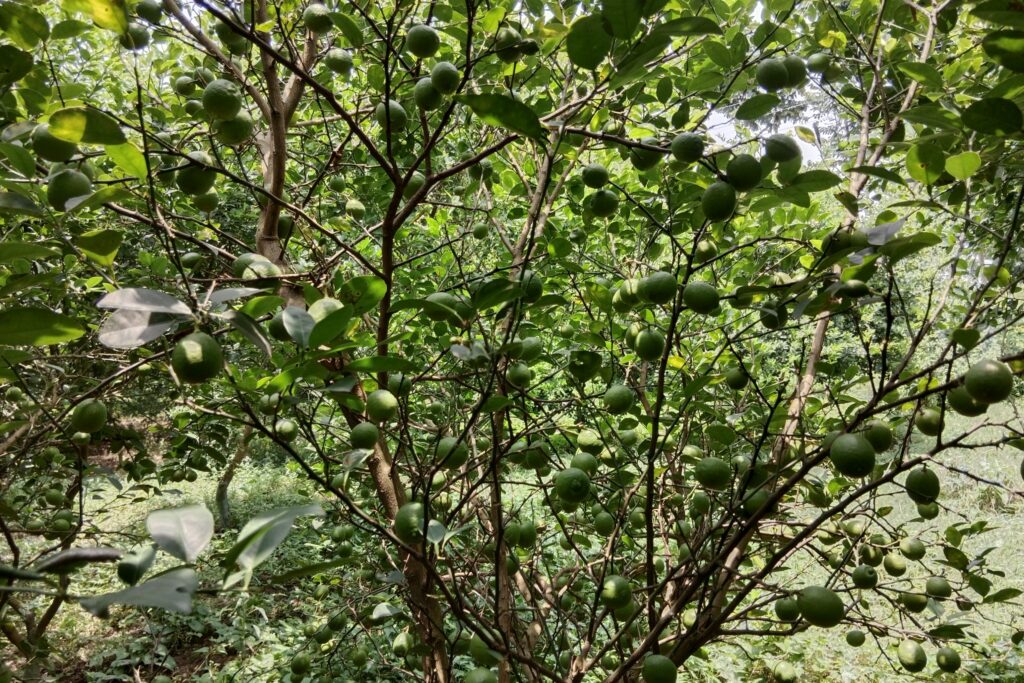Lima Bean Farming Profit Per Acre
Lima bean (Phaseolus lunatus) is a high-value legume recognized for its rich nutritional profile, particularly its protein and fiber content. It is well-suited to warm climates and well-drained soils, making it an important crop for both commercial cultivation and sustainable farming systems. In addition to its economic significance, lima bean contributes to soil fertility through nitrogen fixation, enhancing overall agroecosystem productivity.
Lima bean farming offers excellent financial returns, with cultivating one acre generating a total income of NRs. 210,000 against an investment of NRs. 49,000, resulting in a net profit of NRs. 161,000 per acre. This highlights the significant Lima bean farming profit per acre, with a net profit margin of 76.7% and a remarkable return on investment (ROI) of 328.6%, making it a highly lucrative option for farmers who implement proper management practices.
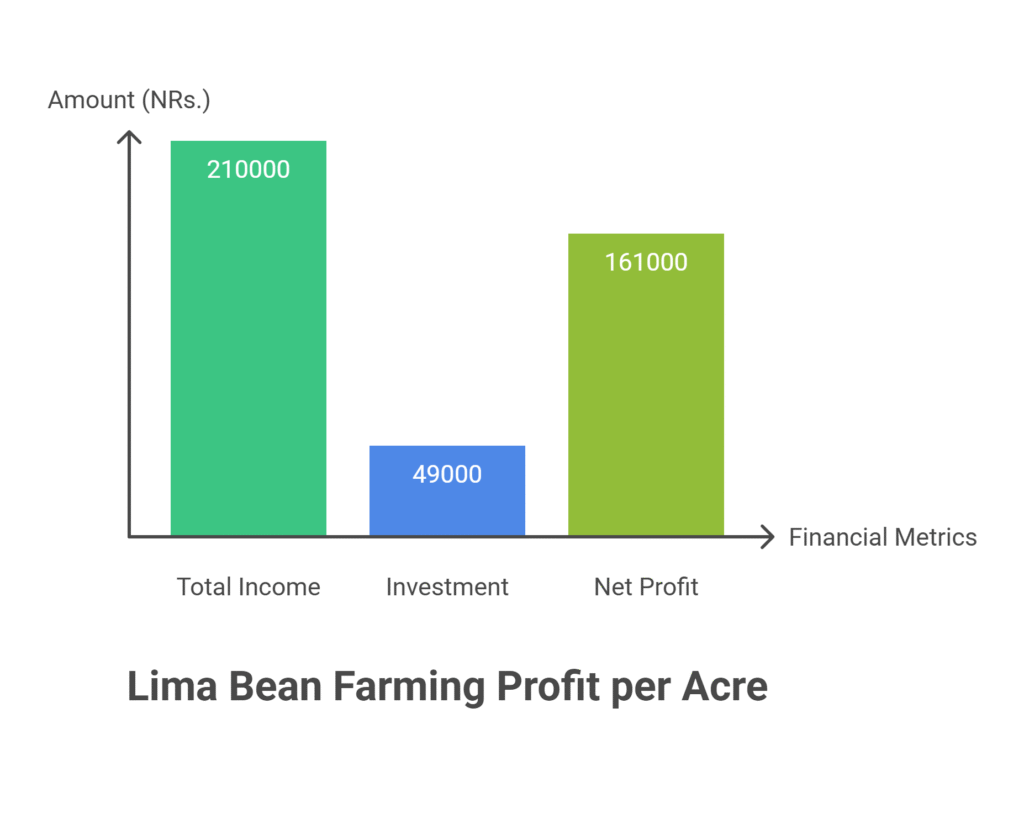
Land Preparation
For lima beans to germinate well and produce healthy roots, the land must be prepared properly. To break up soil compaction and improve aeration, the method starts with deep plowing to a depth of 15–20 cm (6–8 inches). This is followed by two or three rounds of harrowing to break up huge clods and create a fine, flat, and smooth seedbed that facilitates the easy emergence of seedlings.
To reduce competition and get rid of possible insect or disease hosts, the land should also be cleared of weeds, stones, and crop residues. Since lima beans are extremely sensitive to too much moisture, it is advised to create raised beds or ridges in areas with significant rainfall or inadequate drainage to avoid waterlogging.
Soil Type
Lima beans grow best in well-drained, medium-textured loamy soils that provide a good balance of water retention and drainage, with an ideal pH range of 6.0 to 7.0, making soil testing and lime application necessary if the soil is too acidic. While the crop can adapt to different soil types, it performs poorly in heavy, waterlogged clay soils that restrict root growth or in excessively sandy soils that dry out quickly and lack sufficient nutrients.
Climatic Requirements
Lima beans, a warm-season crop highly vulnerable to frost, grow best within a temperature range of 15°C to 27°C (60°F to 80°F). For successful germination, soil temperatures must reach at least 18°C (65°F), as cooler, wet conditions can cause seeds to decay.
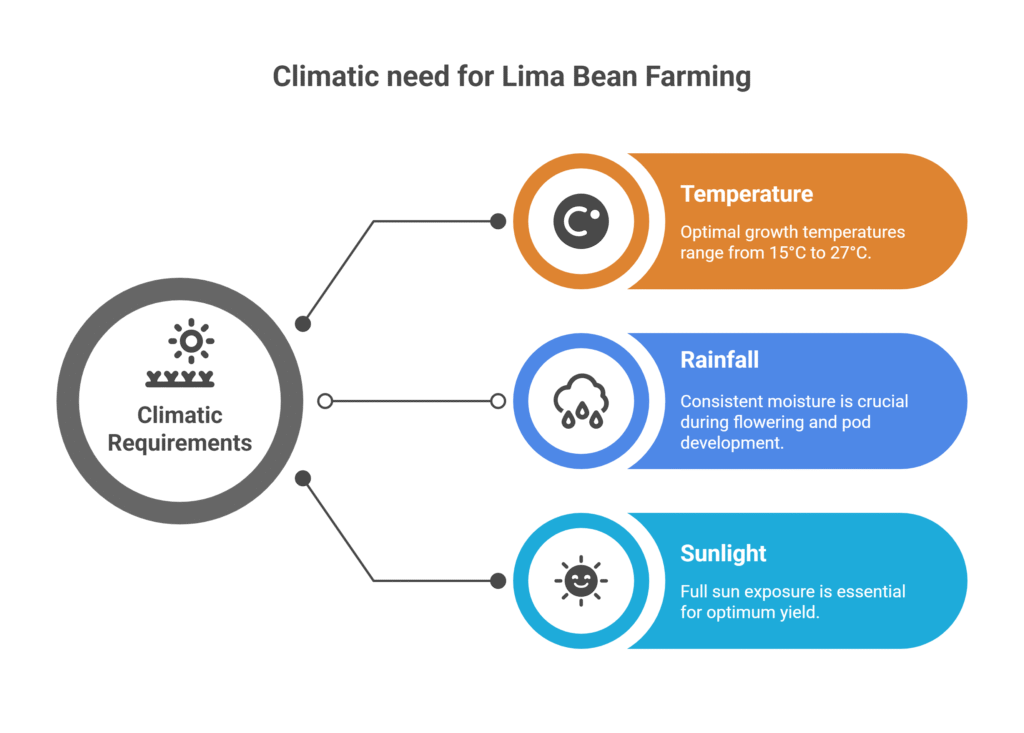
Although moderately drought-tolerant once established, consistent moisture is essential during the flowering and pod development stages. Ideal growth occurs with 500–750 mm (20–30 inches) of rainfall, evenly distributed through the season. It should be noted that excessive rain or high humidity can promote fungal diseases.
Additionally, lima beans require full sun for optimum development and yield, needing no less than 6 to 8 hours of direct sunlight daily.
Major Cultivars
Cultivars are divided into two main types:
| Type | Growth Habit | Maturity (Days) | Support Required | Key Features | Examples |
| Bush Type | Compact, determinate plants (1–2 ft tall) | 65–80 | No | Early maturity, shorter duration, easy to manage | Henderson Bush, Jackson Wonder, Fordhook 242 |
| Pole Type | Indeterminate, vining plants | 85–100 | Yes (trellis/stakes) | Longer growing season, higher yield potential, extended harvesting period | King of the Garden, Christmas, Florida Speckled |
Propagation
Lima beans are propagated solely through seeds, as they are not suitable for grafting or vegetative propagation. Using certified, disease-free seeds from a trusted source is crucial to maintain genetic purity and achieve high germination rates.
Seed Rate per Acre
| Plant Type | Spacing Requirement | Seed Rate per Acre | Remarks |
| Bush Types | Closer spacing, more plants per acre | 20–30 kg | Higher seed rate needed due to compact growth and higher plant population. |
| Pole Types | Wider spacing, fewer plants per acre | 15–20 kg | Lower seed rate since plants spread and cover more area with support. |
Nursery Management
Lima beans are typically direct-seededin the field. They do not transplant well due to their delicate root system. Therefore, raising a nursery and transplanting is not a standard practice for commercial lima bean production.
Planting
a). Planting Season
Planting is typically done in late spring, during the months of April to May.
b). Spacing
| Plant Type | Row Spacing | Seed Spacing (within row) |
| Bush Types | 60–90 cm | 5–10 cm |
| Pole Types | 90–120 cm | 15–20 cm |
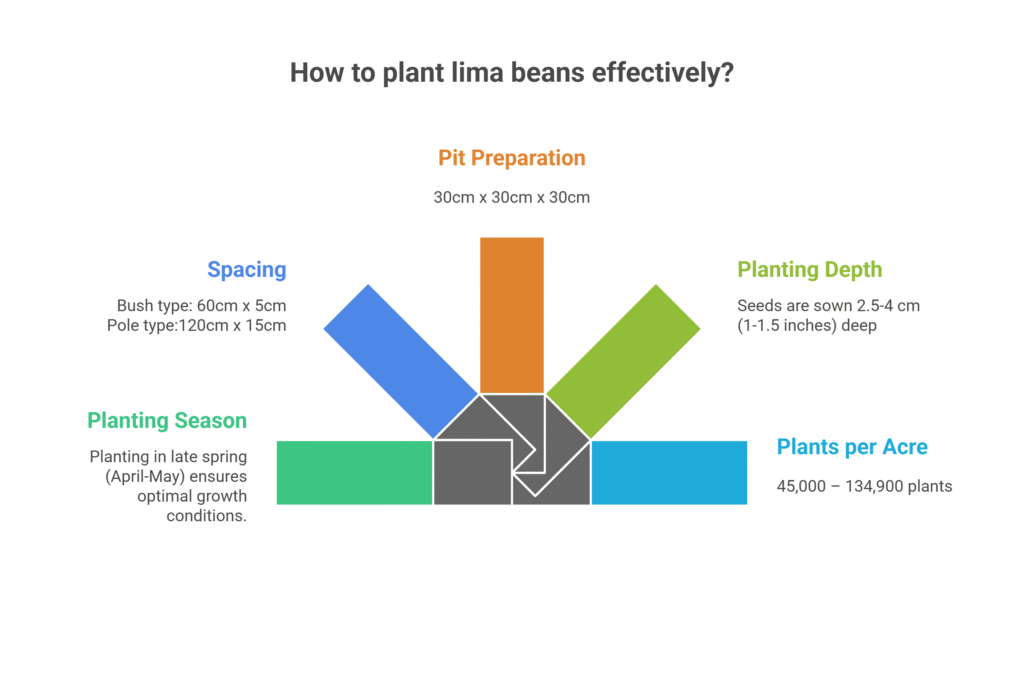
c). Pit Preparation
For pole varieties, prepare pits measuring 30 × 30 × 30 cm and fill them with a mixture of topsoil and well-decomposed organic manure before planting.
d). Planting Method
Seeds are sown 2.5-4 cm (1-1.5 inches) deep. Planting too shallow can expose seeds to drying out; planting too deep can hinder emergence.
e). Number of Plants per Acre
| Plant Type | Number of Plants per Acre |
| Bush Types | 45,000 – 134,900 plants |
| Pole Types | 16,862 – 30,000 plants |
Intercropping
Lima beans, particularly bush types, can be effectively intercropped with taller, upright crops such as maize (corn) or sunflowers, which also serve as natural trellises for pole varieties; however, they should not be intercropped with other legumes to minimize the risk of shared pest and disease pressures.
Irrigation
Irrigation in lima bean farming is essential for healthy growth and yield, starting with maintaining a moist seedbed at planting, with light irrigation if the soil is dry. During early growth, moderate watering is recommended as overwatering can lead to root rot.
The most critical irrigation periods are during flowering and pod development, as moisture stress at this stage can cause blossom and pod drop, drastically reducing yield. Among irrigation methods, drip irrigation is the most efficient, as it supplies water directly to the root zone while keeping foliage dry to lower disease risk, though furrow irrigation is also commonly practiced.
As the crop approaches maturity, irrigation should be reduced, especially when harvesting for dry beans.
Fertilizer and Manure
| Category | Recommendation / Component | Purpose / Notes |
| Nitrogen Fixation | Symbiosis with Rhizobium bacteria | As a legume, lima beans can fix their own atmospheric nitrogen, reducing the need for external nitrogen fertilizer. |
| Basal Application | 5-10 tons/acre of well-decomposed FYM or compost | Incorporated before planting to improve soil structure and provide essential micronutrients. |
| Biofertilizer | 800g/acre of each: Azospirillum, PSB, Potassium Mobilizing Bacteria | Promotes plant growth, solubilizes phosphorus, and makes potassium available to the plant. |
| Inorganic Fertilizer | Phosphorus (P₂O₅): 40-50 kg/acre | Crucial for root development and flowering. A soil test is always the best guide for precise recommendations. |
| Potassium (K₂O): 40-50 kg/acre | Important for overall plant health and disease resistance. | |
| Nitrogen (N): 10-15 kg/acre | A small starter dose to support young plant growth before their natural nitrogen fixation mechanism becomes active. | |
| Inoculation | Treat seeds with appropriate Rhizobium inoculant before planting | Significantly enhances the plant’s nitrogen fixation capability, which can reduce the need for additional nitrogen fertilizers. |
Weed Control
Weed control is crucial in lima bean cultivation as weeds compete for nutrients, water, and light, particularly during the early growth stages. Effective practices include cultural methods such as shallow hoeing and hand weeding, with the first weeding recommended 2–3 weeks after emergence.
For larger fields, mechanical cultivators can be employed between rows, while mulching with organic materials like straw or hay, or using black plastic mulch, helps suppress weeds, conserve soil moisture, and regulate soil temperature.
In addition, pre-emergence herbicides may be applied with caution, ensuring they are registered for use on lima beans and used strictly according to label instructions.
Interculture Operation
Intercultural operations in lima bean farming mainly involve training and vine management, especially for pole types, which require support through trellises, stakes, or tepees to climb. Providing such structures keeps the pods off the ground, reduces disease incidence, facilitates easier harvesting, and enhances both yield and quality. Pruning is generally not practiced in lima beans, with management efforts instead focused on guiding the vines to remain on their support structures.
Flowering and Fruit Management
Flowering in lima beans typically begins 6–8 weeks after planting, and proper management during this stage is vital for good pod set. Adequate moisture and balanced nutrient supply, particularly phosphorus, should be ensured, while excessive use of nitrogen fertilizers must be avoided as it encourages leafy growth instead of flowers and pods. In certain environments, promoting pollinator activity, especially bees, can further enhance pod development and overall yield.
Pest and Disease Management
Common Pests
Aphids
Tiny sap-sucking insects called aphids deplete plants of nutrition and spread viral illnesses. Curling leaves, slowed development, and decreased yield are common symptoms of infested plants. For control, thoroughly mist both sides of the leaves with either insecticidal soap (10–15 ml per liter of water) or neem oil (3–5 ml per liter of water). Whenever infestations continue, repeat every 7–10 days. Aphids can easily become resistant to chemical insecticides, so don’t use them excessively.
Bean Leaf Beetles
Bean leaf beetles feed on leaves and pods, leaving small, round holes that can reduce photosynthesis and market quality of pods. Regular monitoring is important, especially during early growth stages. If infestations become severe, apply a contact insecticide such as lambda-cyhalothrin 5 EC at 0.5 ml per liter of water or imidacloprid 17.8 SL at 0.3 ml per liter of water. Spray in the early morning or late afternoon to minimize harm to beneficial insects.
Spider Mites
Spider mites are common in hot, dry weather, causing yellow stippling on leaves and fine webbing under severe infestations. Heavy infestations can cause leaf drying and premature drop, leading to yield loss. Early control can be achieved by spraying leaves with strong jets of water to dislodge mites. For chemical management, use abamectin 1.9 EC at 0.5 ml per liter of water or fenpyroximate 5 SC at 1 ml per liter of water. Repeat applications may be needed at 10–14 day intervals depending on severity.
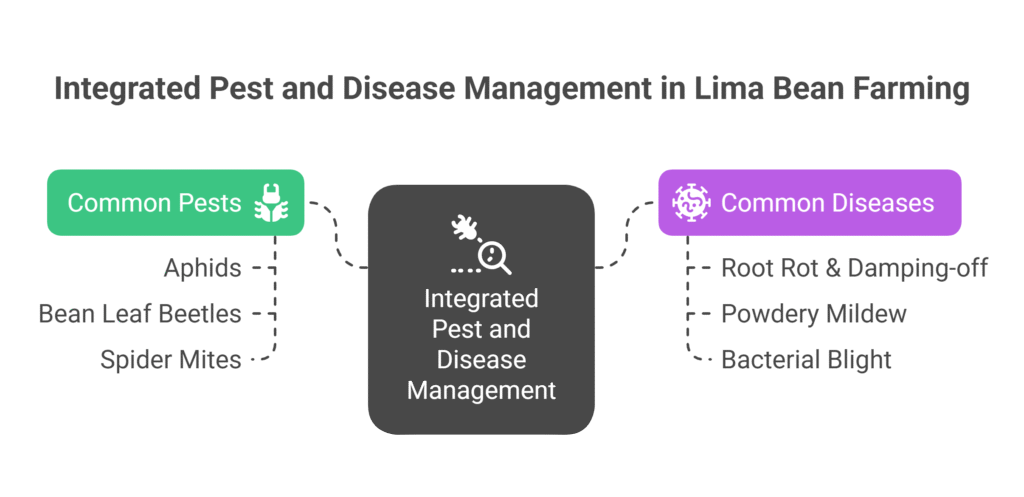
Common Diseases
a). Root Rot & Damping-off
This disease is primarily caused by fungal pathogens such as Pythium, Rhizoctonia, and Fusarium species. These fungi thrive in cool, wet, and poorly drained soils, attacking seeds before they germinate (pre-emergence damping-off) or seedlings at the soil line shortly after they emerge (post-emergence damping-off), causing them to collapse and die.
The key to management is prevention through cultural practices. Ensure good field drainage, avoid overwatering, and use raised beds if necessary to facilitate water runoff. For chemical control, treating seeds with fungicides before planting is highly effective.
A recommended practice is to treat seeds with a fungicide like Thiram at a dose of 2-3 grams per kilogram of seed. For existing outbreaks in the field, drenching the soil with a Copper Oxychloride solution (at a concentration of 2-3 grams per liter of water) can help suppress the disease.
b). Powdery Mildew:
Easily recognized by the distinctive white, powdery fungal growth that develops on the upper surfaces of leaves and stems, powdery mildew is caused by fungus like Erysiphe or Sphaerotheca species. Photosynthesis may be inhibited by this growth, resulting in lower yields.
Reducing excessive nitrogen fertilizer, which encourages dense, vulnerable foliage, and increasing air circulation through appropriate plant spacing are the main goals of cultural management. If the disease manifests, there are a number of efficient fungicides available.
A quantity of two to three grams of wettable sulfur per liter of water should be applied, making sure that all leaf surfaces are well covered. Systemic fungicides such as Hexaconazole (0.5 ml/L) or Azoxystrobin (0.5-1 ml/L) are other efficient choices. Rotating between various fungicide modes of action is advised to avoid resistance.
c). Bacterial Blight:
This disease, caused by the bacterium Pseudomonas syringae pv. syringae, manifests as angular, water-soaked leaf spots that are often delimited by leaf veins. These spots may turn brown and necrotic, and lesions can also appear on pods. Since it is a bacterial disease, standard fungicides are ineffective.
Management is almost entirely reliant on strict cultural practices. Always plant certified, disease-free seed, as the pathogen is often seed-borne. Implement a crop rotation program of at least 2-3 years with non-host crops (like cereals) to reduce bacterial inoculum in the soil. Copper-based bactericides, such as Copper Oxychloride (2-3 g/L), can be applied as a protective spray at the first sign of disease to help limit its spread, but they are not a cure for infected plants. The focus must be on prevention.
Harvesting
Harvest time for lima beans varies depending on whether they are grown for the fresh (shelled) market or for dry beans. For fresh lima beans, pods should be harvested when they are well-filled, bright green, and the seeds are still tender, typically 65–80 days after planting for bush types and 85–100 days for pole types; harvesting is done by hand and often requires multiple pickings.
For dry beans, the pods are left on the plant until they turn brown and dry, with seeds becoming hard and rattling inside the pod. In this case, the entire plant is often pulled and stacked to dry further before threshing to remove the beans from the pods.
Yield
| Yield Type | Bush Types (kg/acre) | Pole Types (kg/acre) |
| Fresh Pod Yield | 2,000 – 4,000 | Significantly higher with good trellising |
| Shelled Green Bean Yield | 600 – 1,200 | — |
| Dry Bean Yield | 800 – 1,500 | Generally higher than bush types |
Cost of Investment Per Acre from Lima Bean
| S.N. | Category | Cost (NRs) |
| 1 | Land Preparation | 15,000 |
| 2 | Seed | 2,000 |
| 3 | Sowing | 4,000 |
| 4 | Fertilizers and Manure | 8,000 |
| 5 | Irrigation | 5,000 |
| 6 | Weed Control | 3,000 |
| 7 | Pest & Disease Control | 3,000 |
| 8 | Harvesting | 5,000 |
| 9 | Miscellaneous Costs | 4,000 |
| Total Investment Cost | 49,000 |
Income per acre from Lima Bean Farming
| Particulars | Estimated Yield (kg/acre) | Market Price (NRs/kg) | Total Income (NRs) |
| Fresh Pod Yield | 3,000 | 70 | 210,000 |
| Total Income | 210,000 |
Analysis of Lima Bean Farming Profit Per Acre
Cultivating one acre of Lima beans generates a total income of NRs. 210,000 against a total investment cost of NRs. 49,000, resulting in a net profit of NRs. 161,000 per acre. This translates to a net profit margin of 76.7% and an impressive return on investment (ROI) of 328.6%, highlighting the high financial viability of Lima bean farming when proper management practices are followed.
Crop Calendar of Lima Bean Farming
This calendar outlines the key management practices from pre-planting to post-harvest for a typical Lima bean crop. Timings are based on a late spring (April-May) planting season.
| Time Period (Relative to Planting) | Growth Stage | Key Operations & Practices | Details & Recommendations |
| 2-3 Weeks Before Planting | Land Preparation | Field Selection & Soil Prep | Select a well-drained field with loamy soil. Conduct deep plowing (15-20 cm deep) followed by 2-3 harrowings to achieve a fine tilth. Clear all weeds and debris. Form raised beds if drainage is poor. |
| Soil Testing & Amendment | Test soil pH and nutrient levels. Apply lime if pH is below 6.0. Incorporate 5-10 tons/acre of well-decomposed FYM or compost into the soil. | ||
| Basal Fertilizer Application | Apply the full recommended dose of Phosphorus (P₂O₅: 40-50 kg/acre) and Potassium (K₂O: 40-50 kg/acre) as a basal dose during final land prep. | ||
| 1 Week Before Planting | Seed Preparation | Seed Selection & Treatment | Select certified, disease-free seeds of a suitable cultivar (Bush or Pole). Treat seeds with Rhizobium biofertilizer (800g/acre) and Thiram fungicide (2-3g/kg seed) to promote nitrogen fixation and prevent damping-off. |
| Day 0 | Planting | Sowing | Sow seeds 2.5-4 cm deep. Bush Types: 60-90 cm between rows, 5-10 cm between seeds. Pole Types: 90-120 cm between rows, 15-20 cm between seeds. For pole types, prepare pits (30x30x30 cm) filled with soil-manure mix. |
| Initial Irrigation | Provide a light irrigation immediately after sowing if soil moisture is insufficient to ensure good germination. | ||
| Week 1-3 | Germination & Seedling Establishment | Weed Control | Perform the first manual weeding or shallow hoeing 2-3 weeks after emergence to remove weeds. Apply mulch to suppress further weed growth. |
| Irrigation | Provide moderate watering. Avoid overwatering to prevent root rot. The soil should be moist but not waterlogged. | ||
| Pest Scouting | Begin monitoring for early pests like bean leaf beetles. | ||
| Week 4 to Flowering | Vegetative Growth | Fertilizer (Top Dress) | If needed, apply a small starter dose of Nitrogen (N: 10-15 kg/acre) to support young plant growth before nodulation. |
| Irrigation | Continue with light, regular irrigation. Drip or furrow irrigation is ideal. | ||
| Support Installation | For pole types, install trellises, stakes, or tepees and train vines to climb them. | ||
| IPM | Continue monitoring for aphids, spider mites, and leaf beetles. Apply recommended bio-pesticides (neem oil) or chemicals only if thresholds are exceeded. | ||
| Flowering & Pod Development | Reproductive Stage | Irrigation (Critical) | This is the most critical period for water. Ensure consistent soil moisture to prevent blossom and pod drop. Do not let the soil dry out. |
| IPM | Monitor closely for pests attracted to flowers and young pods. Watch for signs of powdery mildew and bacterial blight, especially in humid conditions. Apply recommended fungicides/bactericides protectively if necessary. | ||
| Pollination | Promote pollinator (bee) activity by avoiding insecticide sprays during full bloom. | ||
| Week 9-14 (Depending on Type) | Harvesting (Fresh Pods) | Harvesting | For Fresh Green Beans: Harvest begins when pods are bright green, well-filled, and seeds are tender. Bush types mature earlier (65-80 days). Harvest by hand-picking pods; multiple pickings every 5-7 days are needed. |
| Post-Harvest | Handling | Cool freshly harvested pods immediately. Sort, grade, and pack for market to maintain quality and freshness. | |
| Week 14+ (If for Dry Beans) | Harvesting (Dry Beans) | Harvesting | For Dry Beans: Leave pods on plant until they turn brown and dry. Seeds will rattle inside. Often the entire plant is pulled and stacked to dry completely before threshing. |
| After Harvest | Post-Harvest | Field Management | Remove and destroy all crop residues to break pest and disease cycles. Plan crop rotation with non-legume crops (e.g., cereals) for the next season. |
Sources
Food and Agriculture Organization (FAO)
University of California Agriculture & Natural Resources (UC ANR)
European Plant Protection Organization (EPPO)
Punjab Agricultural University (PAU)
Tamil Nadu Agriculture University (TNAU) – Agritech portal
Indian Council of Agricultural Research (ICAR)
Nepal Agricultural Research Council (NARC)
U.S. Department of Agriculture (USDA).
Ministry of Agriculture and Livestock Development (Nepal)
Disclaimer: This crop farming profits assume optimal conditions. Actual results may vary depending on climate, market prices, and farm management practices.

